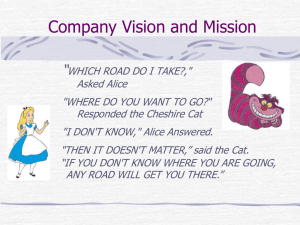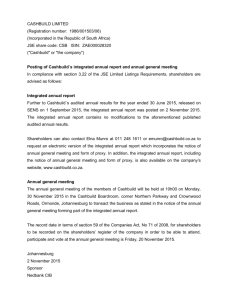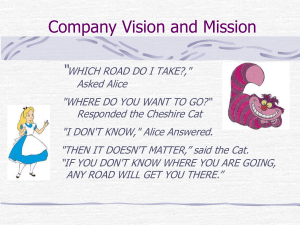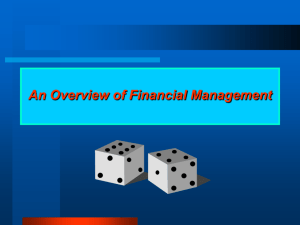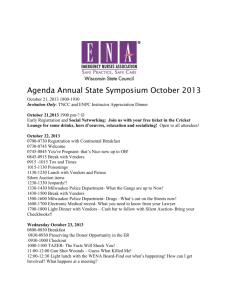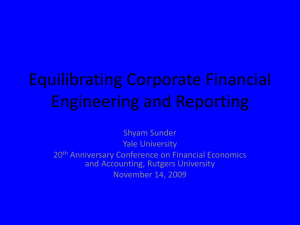Contract Theory of Organizations, Accounting and
advertisement
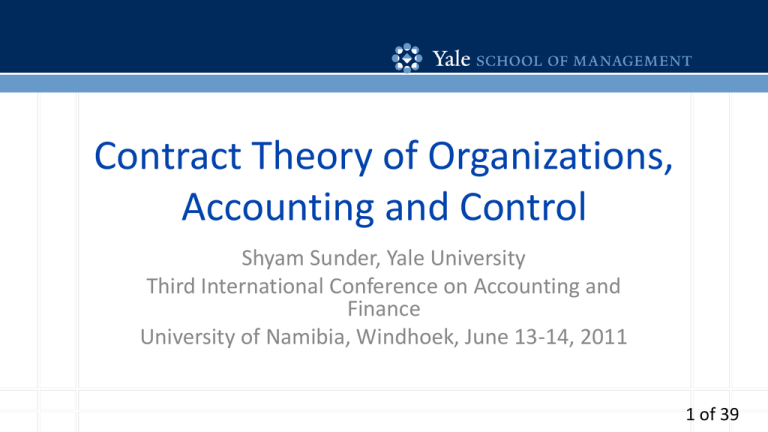
Contract Theory of Organizations, Accounting and Control Shyam Sunder, Yale University Third International Conference on Accounting and Finance University of Namibia, Windhoek, June 13-14, 2011 1 of 39 Three Basic Ideas • Organizations as a set of contracts • Shared facts for conflict resolution • Control in organizations as balance and equilibrium among various interests 2 of 39 Organization as a set of Contracts • • • • • • • Economic agents Contracts Contributions Resource Entitlements Necessary Conditions Satisfies each individual Aggregate feasibility 3 of 39 Shareholders Employees Creditors Customers Managers Government Vendors 4 of 39 Shareholders Sk ills Co mp ens a tio n Equity Capital Residual Rights Employees Creditors t res e t In oan l L ita p Ca Skills Cash Good s Servi and ces Government xe s Ta Pu bl ic G oo ds Managers Customers and s d Goo ices Serv h Cas Compensation Vendors 5 of 39 Contributions and Entitlements of Various Agents 6 of 39 Assumptions • Economic agents • Preferences • Consistency of actions • Contract as mutual understanding or expectation • Not necessarily explicit • Role of social conventions 7 of 39 Goals and Scope • Goals of each individual • Organization’s goals not considered – Organization as an arena – Organization as a tournament • Applicable to all organizations • Focus here on business firm 8 of 39 Functions of Accounting • To Help – – – – – Assemble Implement Enforce Modify Maintain • the contract set through five processes 9 of 39 Five Processes of Accounting • • • • • Measuring resource inflows Measuring resource outflows Determination of contract performance Information for factor markets Common knowledge for contract renegotiation 10 of 39 Measuring Resource Inflows • • • • • Vendors: At the receiving dock Customers: cashier, accounts receivables Labor: clock, inspection Managers: intangible Shareholders: shareholder accounts 11 of 39 Measuring Resource Outflows • • • • Employees: payroll Customers: shipping Vendors: account payables Government: tax accounts • Data organized by cause-effect in double-entry bookkeeping 12 of 39 Contract Performance • • • • • • Compare resource inflows and outflows Determine who has fulfilled contracts, how much Comparative reports Examples: Customer account statement Managerial accounting 13 of 39 Information for Factor Markets • • • • • What resources are expected What resources are available for disbursement Find people who have/want them Markets for labor, goods, and capital Proforma financial statements, business plans and budgets by the entrepreneur • No permanent occupants, must find replacements • Costs and benefits of occupying contractual slots 14 of 39 Common Knowledge for Renegotiation • All contracts have finite terms (except shareholders) • Conditions Change • Potential for Empty as well as Serious Threats and Bluffs • Public Disclosure and Common Knowledge • Cut Deadweight Losses to Society 15 of 39 Necessary Conditions • 1) Individual Condition: Each participants expects to receive at least the opportunity cost of contributions he/she makes to the organization • 2) Aggregate Condition: Contributions of all participants can produce enough output to meet the expectations of all 16 of 39 Income/Value of the Firm • • • • • • • • • Extensive income as the sum of: To the shareholders To customers To Vendors To employees To creditors To government To community, etc. Inducement from the firm – O.C. of contributions 17 of 39 Income/Value to Investors • Residual income and corresponding shareholder value created • Focus of current financial reports • Apply similar perspective to other participants in the firm 18 of 39 Income/Value to Customers • Customer’s “investment” in the form in the form of search, learning, negotiation, payments, settlement of disputes • Expected PV of benefits from goods received should exceed the PV of investments • Includes immediate transaction as well as the consequences of the transaction for resource flows associated with any future transactions (reduction in time, cost, search etc. for later transactions) • In a perfect product market, consumer’s surplus from the firm is zero (may be +ve from industry, and the economy) 19 of 39 Value to Government • Various levels of government provide mostly nonpriced services plus some priced goods • Resources from taxation • Value of the firm to the government from providing priced services is the same as for vendors • Value of the firm to the government from providing non-priced services is taxes plus fees minus O.C. of resources spent on providing services • Major challenge to put this into practice 20 of 39 Value of the Firm to Community • Local, national and global • Most exchanges in form of externalities • Value of the firm to the community is the sum of net externalities plus the net payments 21 of 39 Measurement of Income/Value • J.M. Clark (1936): Three fundamental challenges to determining the value of private enterprise – Imperfect and incomplete markets – Fundamental values not as exact as market values – Fundamental concepts should be independent of specific institutions of exchange (generality) 22 of 39 Problems in Control of Managers • • • • • • • At the procedural hub of the contracts Control resources, have information Monitor and negotiate with others Difficult to measure their contributions Can appropriate resources and information Misappropriation difficult to detect Devising a scheme to induce managers to contribute what is expected of her 23 of 39 Organizations and Accounting By Markets • Organization operate in a variety of markets • Markets vary by the degree of development, frictions, information conditions, competition, and characteristics of resources • Organizations vary by the markets they operate in • Accounting, like electrical system of a building, varies by the nature of organization • We can classify organizations and their accounting on the basis of market characteristics 24 of 39 Classification by Markets • Market for managers (Hatfield, 1924)) • Market for capital (Hatfield, 1924) • Market for product (Sunder, 1999) 25 of 39 Classification by Product Markets • Private good producing organizations (cars, furniture) can be denied revenue by their customers • Shareholders delegate production decisions to hired managers motivated by residual based contracts • Driven by developed product markets 26 of 39 Management Controls Again • A viable concept of control from organizations as sets of contracts, expectations, common knowledge and culture • An organization or group is in control when its members find it in their own best interests to behave in a manner that is expected of them by the other members of the group 27 of 39 Control In Versus Control of • Control in organizations distinct from control of organizations • Control in emphasizes – Balance and equilibrium – Symmetry of points of view of agents • Control of emphasizes – Manipulation, even exploitation • Disparity in bargaining powers of agents 28 of 39 Comprehensive View of Control • Rules, incentives, monitoring, enforcement to align behavior and expectations • Consider two traders on eBay – Buyer expects to have the appropriate goods delivered – Seller expects to be paid – When expectations of both are met, the system is in control • The concept extends well beyond the traditional scope to employees and managers to include shareholders, customers, vendors, and others 29 of 39 Traditional Locus of Control • Processes internal to the firm • Involving people who often have social relationships • In transactions governed by social relationships, shared norms of social exchange play an important role • E-Commerce transactions strip the social context • Scope of e-commerce has expanded well-beyond the traditional boundaries of transactional relationships 30 of 39 Threats to Control • Environment of organizations changes continually (factor and product market conditions) • A contract set which is in control today, will not be in control tomorrow if conditions change • Left to itself, the organization will collapse because a fixed set of contracts cannot remain in expectational equilibrium except by sheer chance 31 of 39 Functions of Top Management • This function goes by many labels (long term planning, strategic management, etc.) • It always amounts to the same thing: – Monitor your environment – Anticipate changes in factor and product markets – Redesign contracts to be in control under the new conditions – Renegotiate contracts – Implement new contracts • Perpetual revision of corporate plans to retain their desirability from the point of view of all participants 32 of 39 Let Me Summarize • Control a key concept in management • Need an appropriate model of organizations to study control • Help do accounting and control better • Find appropriate place for control in the intellectual structure of the discipline of management 33 of 39 Role of Accounting • Organizations as sets of contracts or alliances among people • Agents seeking their own goals contribute resources in exchange for inducements • Accounting helps define, implement, enforce and modify contracts, serving a critical function in organizations 34 of 39 Design of Organizations and Controls • Both designs depend on conditions prevailing in the appropriate markets • Market for managerial labor differentiated stewardship model from bookkeeping • Market for capital differentiated financial reporting model from stewardship • Market for products differentiates government and not-for-profit model from private good organizations 35 of 39 Culture and Control • Culture of a group can be thought of as expectations its members hold about the behavior of others in the group • An organization is in control if the behavior of its members corresponds to the expectations of others • Control is a state of expectational equilibrium 36 of 39 What’s Management For • Changing environment threatens control • Top management must anticipate and deal with these threats to control • Set of feasible corporate plans is too large to contemplate and analyze • Due to time limitations, managers search in the neighborhood of existing plans and settle on satisficing solutions • Simon’s boundedly rational behavior 37 of 39 Finally … • Accounting enables organizations to function, serve all participants • Broad perspective on functions of accounting; accounting systems designed for organizations functioning in different environments • Bookkeeping, managerial accounting, and auditing serve small proprietorship, large proprietorship, and public corporations • Understanding accounting and control in public good-producing organizations that do not have customers, only beneficiaries. Thank You. Shyam.sunder@yale.edu www.som.yale.edu/faculty/sunder Theory of Accounting and Control, 1997 39 of 39



